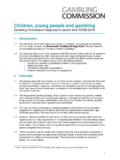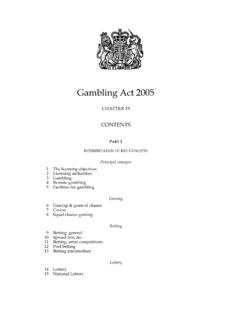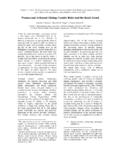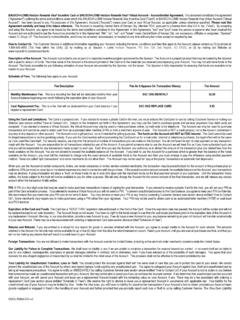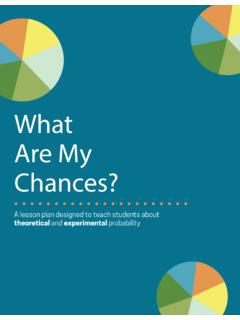Transcription of The Evolving Definition of Pathological Gambling in …
1 NATIONAL CENTER FOR responsible GAMING WHITE PAPER1 One of the most anticipated events in the mental health field is the publication of the fifth edition of the American Psychiatric Association s (APA) Diagnostic and Statistical Manual of Mental Disorders (DSM) in 2013. As the key reference book for mental health professionals, the DSM contains descriptions, symptoms and other criteria for diagnosing mental disorders. According to the APA: These criteria for diagnosis provide a common language among clinicians professionals who treat patients with mental disorders.
2 By clearly defining the criteria for a mental disorder, the DSM helps to ensure that a diagnosis is both accurate and consistent; for example, that a diagnosis of schizophrenia is consistent from one clinician to another, and means the same thing to both of these clinicians, whether they reside in the or other international The APA also states that another important role of the DSM is in the area of research:Only by having consistent (reliable) diagnoses can researchers compare different treatments for similar patients, determine the risk factors and causes for specific disorders, and determine their incidence and prevalence rates.
3 DSM disorders are also used as the basis for treatment indications by the Food and Drug Administration (FDA) for clinical Practice DSM diagnosis criteria are used by clinicians to report disorders to insurers for reimbursement, and to public health authorities for causes of illness and white paper will briefly address the Evolving nature of the DSM, the current diagnostic code for Pathological Gambling (PG) and the proposed changes for the disorder in the NATURE OF THE DSMThe DSM is not a static document. It has been periodically reviewed and significantly revised since the publication of DSM-I in 1952.
4 New research in neurology, genetics, behavioral sciences, epidemiology and other scientific areas have dramatically expanded our understanding of mental illnesses and led to changes in the The Definition of Pathological Gambling (PG) in the DSM-IV (first published in 1994) is the current diagnostic code. To be diagnosed as a Pathological gambler according to the DSM-IV, an individual must meet at least five of the 10 diagnostic criteria, and all criteria are granted equal weight. For the upcoming version of the DSM, the DSM-5 work group has proposed that PG should be renamed Gambling disorder and moved to the category for alcohol and drug use disorders.
5 Based on empirical evidence, the DSM-5 work group also proposed to change the diagnosis of Gambling disorder by eliminating the illegal acts criterion. The threshold for a diagnosis of Gambling disorder will be lowered from five to four Evolving Definition of Pathological Gambling in the DSM-5By Christine Reilly and Nathan Smith National Center for responsible GamingNATIONAL CENTER FOR responsible GAMING WHITE PAPER2 According to the APA, the process for revising the DSM was guided by four principles:11. The highest priority is clinical utility that is, making sure the manual is useful to those who diagnose and treat patients with mental illness, and to the patients being treated.
6 2. All recommendations should be guided by research evidence. 3. Whenever possible, the DSM-5 should maintain continuity with previous editions. 4. No a priori restraints should be placed on the level of change permitted between the DSM-IV and the DSM-5. The APA charged those with revising the manual to consider the impact that any changes would have on clinical practice, prevalence rates and other important factors. At the same time, the task force was instructed to consider the diagnostic advances that would be made through implementation of new scientific knowledge and clinical HISTORY OF Pathological Gambling (PG)PG was added to the DSM in 1980 largely due to the efforts of Dr.
7 Robert Custer, who had treated Pathological gamblers and written about their illness for several years. The original diagnostic criteria included in the DSM-III were not tested beforehand; the diagnosis was based on Custer s clinical experience and that of other treatment The DSM-III criteria began with a statement about the individual experiencing progressive loss of control and then listed seven items, with an emphasis on damage and disruption to the individual s family, personal or vocational pursuits and money-related issues.
8 In this edition, PG was classified as an impulse control the next edition (DSM-IV), the PG criteria were revised to reflect its similarity to substance dependence, such as the addition of repeated unsuccessful attempts to control, cut back or stop Gambling . 3 To be diagnosed as a Pathological gambler according to the DSM-IV, an individual must meet at least five of the 10 diagnostic criteria, and all criteria are granted equal weight. See the box below for the DSM-IV s diagnostic , the DSM-IV noted that the excessive Gambling behavior might be an indication of a manic episode and, therefore, bipolar disorder would be the primary diagnosis.
9 This notation indicated that, even at this early stage, the comorbidity of PG with other psychiatric problems was recognized. Later research by the National Comorbidity Study Replication would verify that 74 percent of cases where the individual with PG meets criteria for another lifetime disorder, at least one other such disorder began at an earlier age than Evolving Definition of Pathological Gambling >DSM-IV DIAGNOSTIC CRITERIA FOR Gambling DISORDERS1. A preoccupation with Gambling ( , preoccupation with reliving past Gambling experiences, handicapping or thinking of ways to get money with which to gamble)2.
10 A need to gamble with increasing amounts of money in order to achieve the desired level of excitement3. Repeated, unsuccessful efforts to control, cut back or stop gambling4. Feels restless or irritable when attempting to cut down or stop Gambling (withdrawal symptoms)5. Uses Gambling as a way of escaping from problems or of relieving a dysphoric mood ( , feelings of hopelessness, guilt, anxiety and depression)6. After losing money Gambling , often returns another day to get even ( chasing one s losses)7. Lies to family members, therapist or others to conceal the extent of one s involvement with gambling8.

